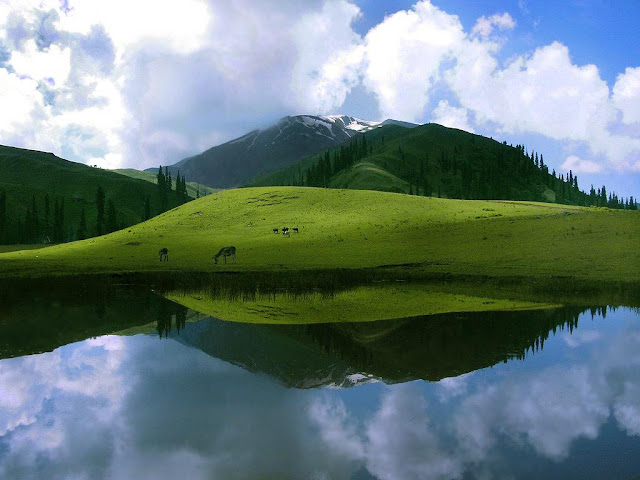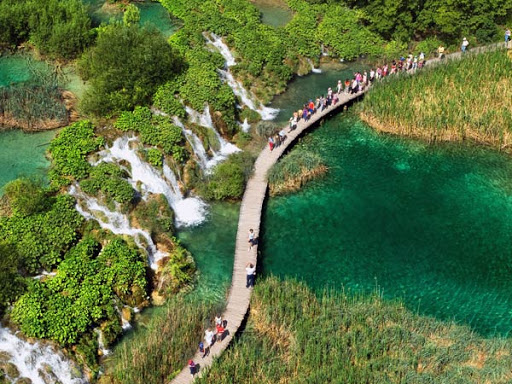10. Lake Atitlán, Guatemala
Nearly a mile up in the highlands of Guatemala, Atitlán (Lago de Atitlán) rests at the foot of three massive conical volcanoes. Small Mayan villages line its shores, which are set off by steep hills draped with oak and pine trees and nearly 800 plant species. There’s no single, must-see view of the lake, so try several vantage points: from up high on Highway 1; from the town of Panajachel, the buzzing market hub that juts out into the water; or aboard a lancha, one of the many small boats that ferry visitors from village to village. We’re saddened to note that the lake has built up high levels of blue-green algae over the years (in October and November 2009, a film of green scum began briefly marring its surface; since then there have been ambitious efforts to solve the problem).

9. Lake Matheson, New Zealand
In New Zeeland lies a lake as clear and still as a mirror. This is Lake Matheson, also known as ‘Mirror Lake’. It is famous for its reflections of the surrounding landscape, especially of Mount Cook and Tasman. It’s one of the most beautiful images one could ever witness. The surrounding wild areas, with its thick vegetation and its very tall ‘rimu’ trees will offer you one of your best walks ever

8. Lake Annecy, France
Surrounded by the French Alps, this lake is not only one of the most beautiful in the world, but also, one of the cleanest, due to the severe regulations. In summer, the entire Paris seems to move to this place. This lake is known for its many touristic attractions as well as for the great views. Annecy has been immortalized in many ways. Subject of paintings and photographs, of literary descriptions and of contemporary stories, this wonder of nature is unforgettable. One cannot see this place and never wish to return

7. Loch Lomond, Scotland
With a backdrop of windswept rolling hills and medieval castles, Loch Lomond feels like it’s straight out of a Victorian romance novel. The 24-mile-long lake is dotted with islands, some so small that they disappear when the water levels are high, and others large enough to be (sparsely) inhabited. Most ferries stop at the largest island, Inchmurrin (population 11), so visitors can get a look at the remains of a 7th-century monastery and the 14th century Lennox Castle, used often as a hunting lodge for kings.

6. Lake Nakuru, Kenya
An African buffalo wades along the shoreline of Kenya's Lake Nakuru. In the background, flamingos feed in the shallow lake.

5. Lake Bled, Slovenia
At Slovenia's Lake Bled, you'll see mountains in every direction, including the Julian Alps and the Karavanke rang

4. Plitvice Lake, Croatia
Plitvice Lakes is the oldest National Park in southeastern Europe. It is also one of the first places added to the UNESCO world heritage. It is famous for the wonderful lakes arranged in cascades. The 16 lakes are formed along the numerous small rivers and are separated by travertine barriers, which represent very sensitive walls made of microorganisms, moss and algae. The fragileness of this unique place was the reason for the strict regulations which apply in the area. Another amazing feature of the lakes is that each of them has its own color, varying from light blue to green and grey.

3. Lake Garda, Italy
Garda is the largest of the Italian lakes and a favored touristic destination. The lake is surrounded by perfect beaches and an amazing landscape. Tourists may enjoy the hot springs, in the south of the lake, the little picturesque villages along the shores and the crests of the Dolomites in the north. For an extraordinary view of the entire lake, you may take a cable car to Mount Blanco. Also, small islands spread across the lake for an enchanting and unique view.

2. Lake Malawi, Malawi
Situated at the border of Malawi, Tanzania and Mozambique, this majestic form of nature has an estimated age of at least 40.000 years and if was formed by the splitting of the African tectonic plate. It is home to 1000 species of beautiful, exotic fish. Sadly, their number is slowly decreasing due to excessive fishing. Lake Malawi represents an important source of nutrition for all the communities which surround this 365 miles long still water.

1. Taal Lake, Philippines
Taal Lake, situated just 37.28 miles south of Manila, has two claims to fame: It is the deepest lake in the Philippines at 564 feet deep, and it is home to one of the world's smallest, but most active, volcanoes.
